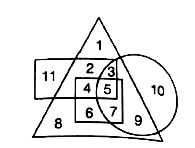Representing whole numbers by squares and rectangles
To represent whole numbers using squares and rectangles, we can follow these steps:
1. Understanding the Concept:
- Whole numbers can be represented visually using dots arranged in squares or rectangles. A square is formed when the number of dots can be arranged in equal rows and columns.
2. Representing the Number 1:
- For the number 1, we can simply use one dot:
∙
3. Representing the Number 4:
- For the number 4, we can arrange the dots in a square formation (2 rows and 2 columns):
∙∙∙∙
4. Representing the Number 6:
- For the number 6, we can arrange the dots in a rectangle (2 rows and 3 columns):
∙∙∙∙∙∙
5. Representing the Number 8:
- For the number 8, we can also arrange the dots in a rectangle (2 rows and 4 columns):
∙∙∙∙∙∙∙∙
6. Representing the Number 9:
- For the number 9, we can arrange the dots in a square formation (3 rows and 3 columns):
∙∙∙∙∙∙∙∙∙
7. Identifying Perfect Squares:
- From the representations, we can see that numbers like 4 and 9 form squares, while numbers like 6 and 8 form rectangles. Perfect squares are numbers that can be arranged in a square shape.
Summary:
- Whole numbers can be represented by arranging dots in squares or rectangles.
- Perfect squares (like 4 and 9) can be arranged in a square shape, while other numbers (like 6 and 8) can be arranged in rectangular shapes.
- Whole numbers can be represented visually using dots arranged in squares or rectangles. A square is formed when the number of dots can be arranged in equal rows and columns.
- For the number 1, we can simply use one dot:
∙
- For the number 4, we can arrange the dots in a square formation (2 rows and 2 columns):
∙∙∙∙
- For the number 6, we can arrange the dots in a rectangle (2 rows and 3 columns):
∙∙∙∙∙∙
- For the number 8, we can also arrange the dots in a rectangle (2 rows and 4 columns):
∙∙∙∙∙∙∙∙
- For the number 9, we can arrange the dots in a square formation (3 rows and 3 columns):
∙∙∙∙∙∙∙∙∙
- From the representations, we can see that numbers like 4 and 9 form squares, while numbers like 6 and 8 form rectangles. Perfect squares are numbers that can be arranged in a square shape.
- Whole numbers can be represented by arranging dots in squares or rectangles.
- Perfect squares (like 4 and 9) can be arranged in a square shape, while other numbers (like 6 and 8) can be arranged in rectangular shapes.
Similar Questions
Knowledge Check
Find the total number of squares in a rectangle having 8 rows and 15 columns.
A345B456C567D606In the given diagram, circle represents Professionals, square represents Dancers, triangle represents Musicians and rectangle Europeans. Different region in the diagram are numbered 1 to 11 . Who among the following is neither a Dancer nor a Musician but is professional and not a European?
 A8B11C1D10
A8B11C1D10The number of rectangles excluding squares from a reactangle of size of 12×8 is :
A1234B625C2460D256
Find the total number of squares and total number of rectangles in the following figure. The main figure itself is a square.

View SolutionFind the number of rectangles excluding squares from a rectangle of size 9 × 6.
View SolutionFind the ratio of number of circles and number of squares inside the following rectangle:

View SolutionFind the total number of squares and total number of rectangles in the following figure.
The smallest unit (or cell) in this figure is a square.

View SolutionThe number of rectangles excluding squares from a rectangle of 9×6 size is
View Solution
